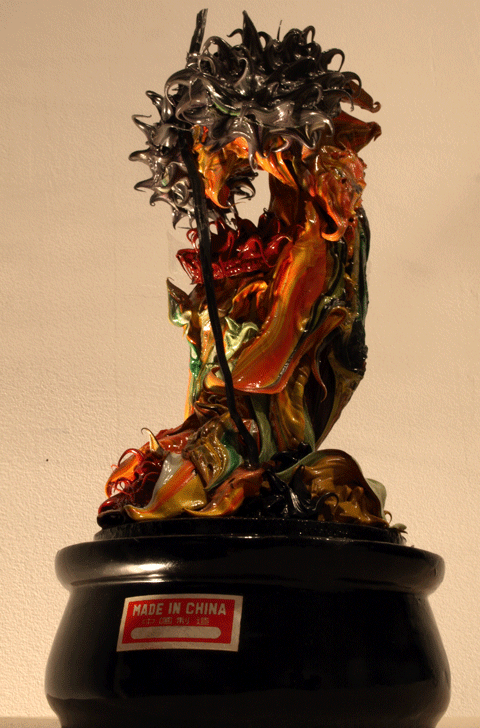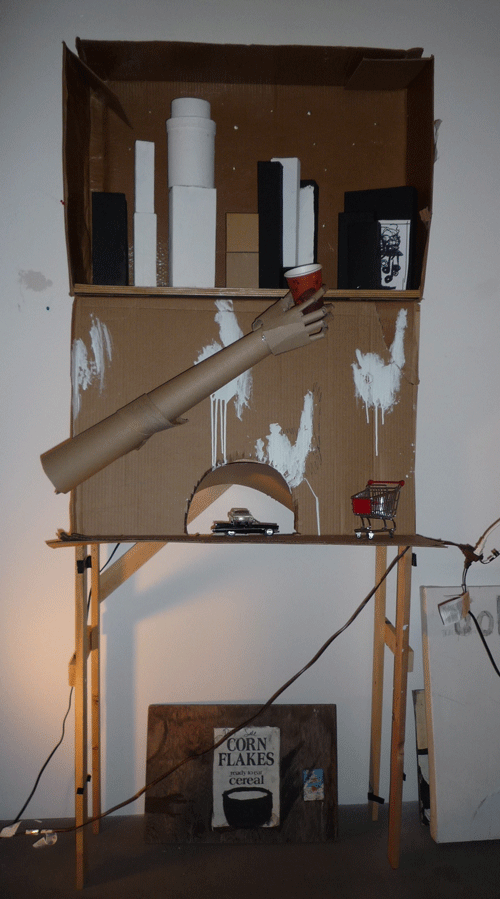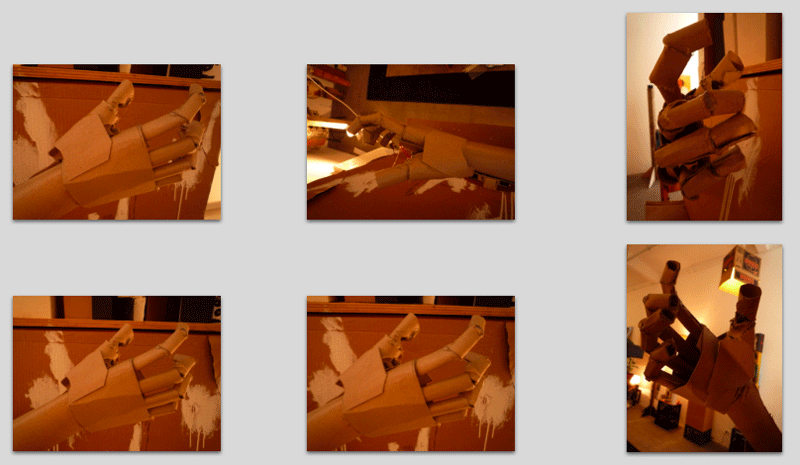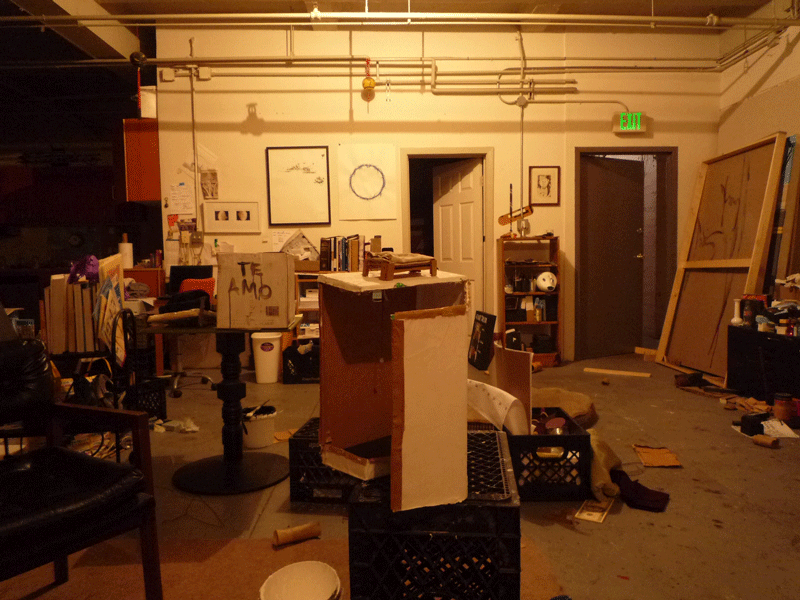April 8, 2009
Mail Call

Harold Hollingsworth, my distant cousin, wrote in:
Dennis/CousAre you blowing those spores up in scale, cause if so, I'm in! It is the year of go big or go home, and your moves, if larger in all scale of subject, and that is how I see your marks, will be the path, hope you are well!
--
harold hollingsworth
Here's my reply:
Hey there Harold:There's a natural limit to the size of the monads. Already, my paintings are super heavy. If I go larger, it will have to be via some kind of special fabrication, Hollywood style... and I'm not into the histrionics of the hyper extended pan media artist.*1 I would prefer to move in terms of painting than move in terms of trans-media.
Is painting over? I was told that this was the case back in grad school, but being a stubborn son of a gun, I was determined to continue with my ambition to paint. The author was very much alive and his death was far too exaggerated... as a matter of fact, we in the art world tend to literalize metaphor and artifice. On the other hand, I was leafing through a catalog of Eva Hesse yesterday, and I could see how she took a cue from her paintings and sprung into sculpture. But then again, her spring board was more elemental (line and tentative feeling) than something in terms of a specifically defined form. Perhaps this is the best guideline for pan media extensions: that the script for the jump should be conceptual rather than formal.
Is painting over? I thought I found something like a hidden pull down menu for painting: a formal element natural to paint itself, a reassertion of the materiality and reality of paint, an unpopular counter-argument against the conceptual sidestep that art history took. I used to argue that Clem Greenberg missed the point when he emphasized a disembodied argument for the imagistics of painting. By pushing the materiality of paint, have I inadvertently sidelined imagistics and therefore painting in general? Quite possibly.
Of course, if I could pony up a five figure budget and make what you're talking about with a simple phone call, Jeff Koons style, that'd be the way to go. But right now I can only make bunny ears with my pockets pulled inside out.
Thanks for the encouragement, it's much appreciated. Photo close ups in the blog tend to get people excited like that. The blog is perhaps misleading in that way. People tend to light up when they see the vitrines in person too. Some people have asked me if I would make them larger. Maybe I should try glass blowing or find a shop somewhere who could make vitrine where a person could stand inside? I wonder...
Many moons ago, my old navy buddy was egging me on to do the same thing. Same answer. The big question is how much an artist should play to the audience and how much can we lead? Maybe the former should be dammed and the latter is the only way to go for the real artist. And maybe an artist who can't hear critique is a self absorbed narcissist. But like the arguments of abstraction/representation or democrat/republican I tend to think that it's not about one or the other but about both. The question is about how much and in what proportion can one simultaneously follow a vision and live in a community that acts on the stage of art history.
Thanks again,
-Dennis
UPDATE: *1: "I'm not into the histrionics of the hyper extended pan media artist."
Well, this sentence is a bit over the top. I do have a critique against forced diversification, compelled by the popular notion that since we are living in diverse times, that all artists have a duty to reflect and represent such diversity by expressing themselves in a conventional spectrum of media.
This should not be confused with those artists who naturally follow their curiosity into a variety of mediated expressions. The operative word here is "curiosity" (Ahem. #1) External voices, regardless of how intelligent they might be, should never be permitted to displace the origin of vision that each of us are born with in this world. I have, we all have encountered those artists whose curiosity has a naturally wide address... but in an art world so burgeoning with artists, and with conventions of representation that are widely disseminated, it is a bit hard to read this distinction between the authentic and the programmatic easily upon first glance.
But these distinctions exist for certain. There is a way, and there are many ways, to do the spectra well.
Indeed, since I had substituted undergrad architecture with undergrad art school, my belief in this spectrum is nicely anchored and as hard as concrete. The deal is that when I have dipped into each experience, I tend to drink deeply. Three examples: Since I was raised as an AirForce brat and since my father was such a legendary figure for me (he fought in Korea, thrown into the maw of the Pusan perimeter at the onset of the war, all of which he was quiet about, by the way), it was incumbent upon me to matriculate into the armed services. So I joined the Navy for 4+1 years (the plus one to get an interesting job while I was at it). Architecture: 6 years of school and four in the field for apprenticeship and licensure. Painting: 18 years plus 6 overlapped.
With what I hope is a small risk of braggadocio, I submit these biographical facts for the record.
I do in fact, love all media. I am however, a particular kind of lover of all media.
The crux of the matter for me probably is an issue of simultaneity, something about which one should perhaps not be so Taliban about.
I would very-much-like to live long enough to dip deeply in each well. (Pause for prayer.)
Amen.
***
The question as to where the vitrines are leading is touched upon in the next email.
Chris Ashley wrote in recently:
Dennis, the vitrines that you've shown on your blog, and the April 1 post showing the wood (not cardboard, right?) armature, are fascinating as individual objects, first, but also in how they are revealing extensions of the kinds of structure, figuration, and space that exist in your paintings, maybe similar to the way de Kooning's 60's sculptures made clear how he thought of or felt about the figures in his paintings at that time. I like yours, and wonder if you intend to make more.Best wishes,
Chris
Hey Chris:Posted by Dennis at April 8, 2009 11:55 PMThanks so much for the encouraging words. Yes, that's cardboard and cork that you see, attached with hot glue into a rigid armature using boxed frames and cantilevers. I buy the vitrines at the local curio shops here in Chinatown, take them apart and insert these assemblages. These things are straight extensions from the painting project, using the menu of three dimensional touches to agglomerate a form. I paint the elements onto a paper palette and let them dry (I refer to this as my oyster breeding farm), at least to the skin. Once the skin gets leathery, I slice them off the palette and attach them to the armature, the wet cores being a perfect adhesive.
I'm having fun, but I am also figuring out along the way, the limitations/possibilities of a transliteration of painting into sculpture. A few friends are quite excited, telling me that I should shift form painting to sculpture, that this is a better expression of who I am. I take the compliment but I am not sure about that entirely. Others want this to remain a "B project" or even a passing fancy. I tend to think that the scale limitations will keep this in a B-level and this level is a bit crowded, the blog for example. I am not particularly eager to merely scale up to a six foot vitrine... but then again I saw a glass case here in CT that is a bit inspiring. I have no axe to grind against the pan-genre artists, but I do believe that to get anything interesting done in painting, one has to get an exclusive mindset about it, Jack of all trades and all that. I do hold out a possibility that once I have found a base camp on Mount Painting, extensions into other arenas are possible. Again, the blog is an example, even though it has no cred as a recognized medium in our art world.
Yet.
As far as sculpture, I have had an abiding interest in the type of sculptural practice that mashes and manipulates material. Clay more than carving comes to mind. I like the kneading and dexterity that are involved in this approach. I tend to think that this is an overlooked avenue in our artworld, with many fellow artists valuing the maxim that art material is anything within your reach. The recent assistance I rendered for Henry Taylor as he prepared for his show here at MeslerHug is a good example. For some time, I had been thinking about mashing cardboard together with hot glue, kneading and shaping busts that explore character and anatomy along the way. I wanted to use Henry as a model, so when he asked if I could help him assemble some things, I was all too happy to assist.
As an aside, I have always admired Tom Sachs' work, and I had long thought that in a parallel art universe, there is a Dennis exploring along that vein. My only beef with his stuff is the hard anchor to explications of Theory (...sorry, this is a digression to an incidental remark... a double-down drift). From my experience in architecture, model making and conceptual instrumentality has always been very exciting.
Henry's studio is full of discarded cardboard boxes, a prime element in his palette. I had suggested that I could be of some help to him if he ever wanted to mash the cardboard into new forms. One day last fall, Henry asked if I could help him create a life sized figure in cardboard. Keeping to his language, I quick assembled a box to the dimensions he was thinking of. Along the way, we endowed what became his football player with gonads, painted it black and I mashed together a right arm as Henry topped it off with one of his mannequin heads that he tends to have on hand.I should know who wears # 45, but I don't. Alas, alack.
Several months later, I had a chance to make the sculpture I was thinking of, a bust of Henry himself. As I started to glue of the cardboard forms, Henry kept handing me materials, a foam display head (already painted), so I dropped my intention. I was in his studio after all, not mine. He handed me a plastic packaging element as an example of the type of material he tends to like in his sculptures... as it happened: anything within his reach. So I put my agenda aside and incorporated his palette, cutting the chin and mouth off the foam head so I could cock it back and indicate Henry's characteristic occipital shape of his skull. I shaped a forehead as it covered the existing foam face and then I jacked in the plastic packaging for a nose and reattached the chin/mouth for a final flourish. I thought Henry would slather it with paper mache, to naught. It was all fun for me, but still I was thinking of the plastic aspect of sculpture.
A couple of nights ago, a group of us were helping Henry put together a piece that he had been thinking about as his hours of prep time for the show dwindled. He was thinking about the haves/have-not life of living in downtown LA, and he wanted to make a city scape with street life below and a hand reaching up for what would eventually be either a request for alms or a toast for an empty hand, he was thinking of how to fabricate the hand: wire and paper mache? I told him that I could throw together one from cardboard splish-splash (I was still dwelling on the idea of the plastic potential of cardboard), so I started whipping out a hand in cardboard as fast as I could.
I had a great time with it. And I am indeed planning to explore it further.
Last night is another example. Henry and I were in his studio, and he had started to make what would amount to a prison cell from a cardboard box. What kind of cell was it? What color was the floor? Concrete or wood? Should the walls be brick? No, that's old school. Henry was thinking of something specific and contemporary. What kind of bed was it? A cot. So I started to make a cot with whatever was at hand, in Henry's way. Corrugated cardboard cut with scissors and razor blades, folded knit rags to make a mattress. I even made a pillow and stuffed it. Henry, by this time had made a commode from the severed top of a clorox bottle, he flipped it upside down, painted it and placed it in the cell. Then I asked if the cell had a light in it. Was it a bare bulb? (This was a leading question, I was thinking of a Guston bulb.) I then made something out of wire and hot glue. I suspended it in the room. After a time (4 am to be exact), Henry said: "I think it's too much like a doll house." And then I began to understand a little bit about his aesthetic: there was a issue of poetics in play here, not only the poetics of his subject, but of the way he reached for and manipulated his materials. My inclinations were too specific for him, it was driving him off his game.All in all, I'm learning a lot, and basic issues are still in play. But I think that there is something to your observation about the armature, and I think that my recent adventures with Henry are an illustration of this. I'm not sure where all this is going, but I'm having some fun along the way.
I've been drifting off into an idea of an image of a first stage of a seppuku in chip board: a desultory samurai sitting against the wall with nearly a square cut out of his abdomen, cardboard entrails and viscera spilling out onto his lap.
Don't ask me why.
Thanks again and I look forward to a physical toast together when we first get a chance some day soon,
-Dennis





Leave a comment